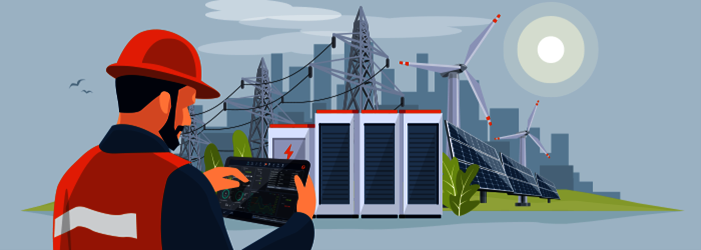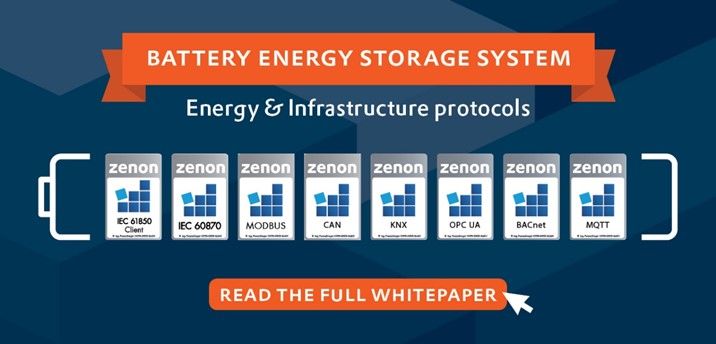Battery energy storage’s increasing significance for energy distribution

When it comes to energy distribution, reliability and high availability are some of the most pressing concerns. A battery energy storage system (BESS) helps provide these characteristics to an energy distribution system. Modern energy management systems (EMS) need to manage and disperse energy, making energy storage an invaluable tool for delivering power to the right location when needed. A BESS can also provide other benefits, like reducing costs and greenhouse gas emissions. It can be used when outages occur in power lines, in primary substations, or during scheduled interruptions.
Let's take a closer look at the BESS, how it works with your grid management systems and why it's such an essential component of your overall system.
What is a BESS?
A BESS is a type of energy storage system that builds up and stores energy to be discharged and distributed at a later time. It must be controlled by an energy management system, which coordinates the different components involved for a fully optimized process. Energy distributors can use a BESS to collect excess energy and deliver it to critical sources during power outages. Power recipients might include emergency, medical and industrial facilities.
The components within a BESS include the batteries, the software systems that control it, and required auxiliary resources like temperature, fire, and ventilation control systems. Often, a BESS uses lithium-ion batteries, but other options include lead-acid, nickel-cadmium, flow, and sodium-sulfur batteries, each of which has unique advantages and disadvantages.
A BESS can offer a wide range of benefits, including:
- Efficiency improvements: Using a BESS helps minimize loss within distribution systems to reduce operational costs. Detailed monitoring information provides insights into generation and consumption behaviors, allowing the utility distributor to optimize the system and reduce the costs of generation.
- Reliability: Wind and solar energy can vary in how much power is produced in a given time. They are intermittent and unpredictable. With a BESS, renewable energy producers can keep capacity at a high level to meet demands, even during periods of low sun or wind.
- Energy arbitrage: You can charge up the BESS batteries when electricity prices are low, and when prices are high, discharge them and sell the energy. This ability can be particularly useful for solar energy, where utility providers can retain high-availability energy until it fetches a higher price.
- Frequency regulation: Some types of power generation result in inconsistent frequencies. A BESS can provide a fast frequency response (FFR), which quickly addresses frequency changes to reduce the imbalance between multiple synchronous generators. Other systems can take longer, but a BESS works within seconds to get resources online faster.
- Flexibility: A BESS is relatively easy to install because the batteries can be placed anywhere. You don't need to work around natural resources, like underground reservoirs or locations with high wind speeds.
- Better results for the user: A BESS is helpful for the utility provider and the end user, as it helps improve power quality. Better power allows users to achieve more reliable operations and potentially see cost savings.
In short, a BESS can significantly increase the reliability and profitability of an electrical distribution system. As renewable energy becomes more viable and dependable, experts expect the global BESS market to grow with a compound annual growth rate (CAGR) of 16.3% by 2029.
How a BESS supports different types of energy
A BESS works especially well for certain types of energy production and distribution by addressing their shortcomings, such as unpredictability and variation. It is a major part of allowing utility companies or businesses to switch to renewable energy while maintaining high uptime and performance.
Solar power
Solar power is susceptible to intermittent results. The sun doesn't always shine, and when it does, the energy needs to be stored for use when it isn't, like overnight and on cloudy days. The BESS can accomplish this storage and function as a frequency regulator to maintain the system's stability. Solar power calls for the correct output frequency for each instance of photovoltaic penetration to reach the acceptable limits of the grid code. As an energy arbitrage tool, BESS also supports high-cost savings for the overall success of the installation.
Using a BESS in combination with EMS has been found to be an especially promising solution for microgrids, where the electrical networks can make the system more vulnerable to intermittency and dynamic loads.
Wind power
Wind power has similar limitations, with intermittent availability and output fluctuations. A BESS offers control for these unpredictable conditions, so wind energy installations can continue to provide reliable power and higher revenue.
Conventional power generation
Electricity generated from fossil fuels or nuclear power can also benefit from a BESS. Most energy produced in the U.S. still comes from natural gas and coal. Again, a BESS offers energy arbitration capabilities to help improve the system's profitability, but it can also increase the system's efficiency by accessing stored energy when necessary. Even if your power supply is dependable, outages can occur due to damages or problems in the delivery system. A BESS helps by providing backup power to meet customer demand even in emergent situations.
It can also play a significant role in switching from non-renewable to renewable energy sources by providing energy storage to compensate for unpredictability while implementing new energy sources.

Just WHAT do we imply by the term "BESS"?
It is possible to store energy in a battery energy storage system (BESS) by charging it from the grid or a power plant and then discharging it when electricity or other grid services are needed.
WHY is it necessary to have a BESS on a utility-scale?
BESS that are deployed on a utility scale improve grid stability by compensating for gaps and interruptions in power transfer. Alterations in sectors of the economy that consume a significant amount of energy in the future will create possibilities for investments in innovative technologies that have the potential to make sectors more resilient and cut carbon emissions.
HOW can batteries make it easier to store and distribute energy from renewable sources?
BESS can add to or replace existing power networks if it is built on a large scale and kept in place.
BESS and IIoT
Another important consideration for BESS is how it integrates with the Industrial Internet of Things (IIoT). A BESS relies on an array of inputs regarding system status, demand, and output. Connecting your BESS to IoT devices is vital for ongoing monitoring, assessment, and data collection. The IIoT industry can leverage BESS to help create a vast network of reliable, consistent energy delivery worldwide. It also allows technicians to manage energy distribution with much more data at hand and from off-site locations.
Achieve better reliability with zenon
If you're looking to reap the benefits of BESS and improve the efficiency and reliability of energy distribution, COPA-DATA can help. Our energy automation software, zenon, is built to support your energy distribution system from start to finish. This powerful platform meets a range of industry standards, like ISO and IEEE, to cultivate a dependable energy environment with the flexibility you need to adapt to new technologies, like IoT and cloud-based solutions. zenon is packed with tools to monitor, control and optimize your network, including visualization and machine learning.
To top it all off, our Service Level Agreement ensures you get comprehensive support from the COPA-DATA team. We'll give you access to a wide range of online resources, training courses and technical support. Reach out to an expert today to learn more about zenon and how we help you make the most of your energy distribution system.

















































